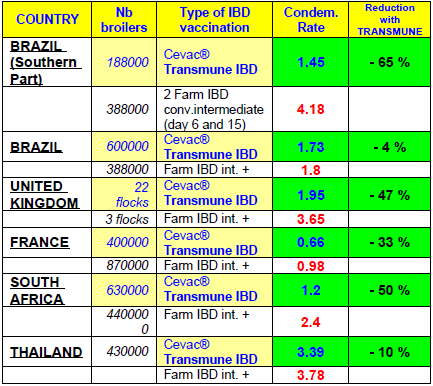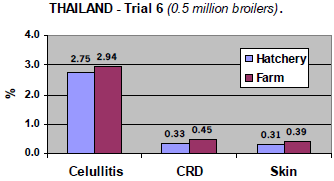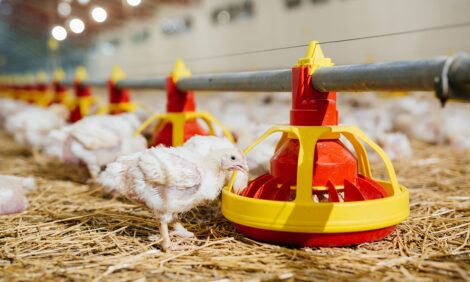



Reduction of Condemnation Through Vaccination in the Hatchery
By Marcelo Paniago and Vincent Turblin.Introduction

Total or partial condemnation of carcasses in the slaughter houses has always been a major concern for the poultry industry as it represents huge economical losses for companies : yearly, more than 70 million USD including 35 million USD only for cellulitis!
Undoubtedly, with intensification of production, cellulitis has become a leading condemnation category and therefore a major concern for broiler producers in recent years. A retrospective survey in Canada showed for instance that in 20 years the lost caused to the farmers were multiplied by 17 factor, reaching 0.8 per cent.
Because of these enormous losses, the broiler industry has constantly tried to improve the facilities, optimized the stock densities and even improved some management techniques. Furthermore, broiler producers seek continuously for new ways of reducing the condemnation rates at the slaughter house.
Recently, more and more trials demonstrated that concentrating the vaccination in the hatchery could significantly improve the profitability of the companies. Indeed, the reduction of vaccinations applied in the farms can contribute to reduce the condemnation at the processing plant and consequently the big lost induced.
Vaccination in the Hatcheries vs Condemnation Rates
The vaccination of the day-old chicks in the hatcheries effectively started in the 70’s with the development of the vaccine against Marek’s Disease (MD). Over the years it has become an increasingly important practice in poultry industry.
There are several reasons for moving the vaccination from the farm towards the hatchery. It saves costs and improves the logistics of the vaccinations, reduces the stress of the birds while avoiding problems related to massive vaccination in the farm and stops the risk of spreading diseases through the vaccination crews. Furthermore, in a production structure of any integrated company, it is much easier to provide more uniform vaccination to all chicks when it is carried out in one hatchery instead of doing it in hundreds of farms.
Recently, some field trials have demonstrated one additional benefit to the ones aforementioned. Flocks vaccinated in the hatchery have shown less rates of condemnation in comparison to the ones vaccinated in the farms (as related in the table 1 below).

For each of these comparative trials, the broilers were reared in the same organizations, and thus according to the same vaccine program except, obviously, IBD prevention. For information, in Brazil, all the broilers must be vaccinated against Marek besides the classical program. Some comments are added afterwards with interesting details in the breakdown of condemnation rates mainly.
Trial 1 and 2 : BRAZIL
The first trial was carried out in a company located in the Southern part of Brazil in a region considered of low IBD challenge, and therefore vaccinating only with intermediate strain (twice). The first observation was a significant improvement of the field performance of those flocks vaccinated in the hatcheries with reduction of mortality, reduction of FCR and consequently improvement of the efficiency index. Going into more details, those flocks vaccinated with Cevac® Transmune IBD in the hatcheries had significantly lower condemnation rates due to airsaculitis, cellulitis and other pathologies.
The second large field comparative trial included intermediate plus IBD vaccine as vaccine in the farm and showed a reduction in the overall condemnation rates, being noticeable through the decrease of condemnation due to unthriftness (development problems – decreased body weight gain, lack of uniformity – of domestic animals commercially raised) and cellulitis.
The details are illustrated by the graphics here below.
 |
 |
Trial 6:
In a major integrated company in Thailand, three consecutives trials, involving approximately 430,000 broilers, were carried out with the objective to evaluate the field performance and the condemnation at the processing plant. Thanks to Transmune vaccination, one group of broilers had the vaccination program concentrated in the hatcheries and hence reducing the number of vaccines applied at the farm.

Even if the global result is not significantly different, the condemnation rates observed at the slaughter plant was nearly 0.5 point lower for the hatchery group than for those flocks vaccinated against IBD at the farm. Moreover, there was a reduction in the three main criteria evaluated by this company: cellulitis, CRD and skin lesions.
Factors for Condemnation Rates Reduction
It is clear that different companies adopt different criteria to evaluate their condemnation rates at the slaughter plant. Nevertheless, in all these six aforementioned trials, carried out in different parts of the world, there was a reduction in the condemnation rates when the vaccination was concentrated in the hatcheries. As these findings do not seem to be just a coincidence, it is necessary to speculate what would be the reasons for such an improvement in the condemnation rate at the processing plant and consequently increasing the meat yield.
Undoubtedly, production practices at the farms have a major influence on the quality of carcasses in slaughter house. Speaking about cellulitis, the main issue is the skin integrity. Consequently, a fairly lengthy list of conditions and management factors appear to have positive correlation with its development. Stock density, quality of the litter, ventilation, downtime between flocks, feed space, lighting programs, temperature and others. In fact, it is also necessary to consider that some other predisposing factors associated with cellulitis are related to the chicken itself like feathering, growth rate, sex, breed, behavior and others.
Moreover, the possibility of increasing problems with scratches when birds rapidly move either to feeders or drinkers was already documented. Therefore, the reduction of occurrence of cellulitis in the flocks vaccinated in the hatcheries can be attributed to the reduction of the frantic movement of the broilers during the drinking water vaccination at the farms. During this process, it is a common practice to withdraw the water supply in order to make the broilers thirsty. Consequently, after making the vaccine solution available, the birds tend to rush to the drinkers, contributing to increase the scratches on their skin which may become contaminated and therefore leading to cellulitis.
Another possibility could be related to the IBD pressure management. Even though no clinical IBD outbreak was reported in the flocks vaccinated at the farms of the six aforementioned trials, there could have been a sub-clinical disease and therefore some of the condemnations were related to it. After introducing Cevac® Transmune IBD in the hatcheries, this sub-clinical disease was efficiently controlled and hence the condemnations dropped down.
Even the stress associated with the farm vaccination may also be considered, to certain extent, as a cause of the increase of the condemnation rates in the processing plants. By reducing the stress, a positive impact may be seen on the reduction of those losses. However, even though it is clear that there is some level of stress associated with vaccination at the farms, it is not very easy to demonstrate.
Conclusion
The causes leading to carcass condemnation in the processing plant are complex and multi-factorial. Hence, their reduction through improvement of production practices is not a simple task and the poultry industry has to keep enhancing the conditions which allow the growers to achieve good field performance without increasing the condemnation rates at the processing plant.
The adoption of hatchery vaccination, and therefore reducing the number of the vaccination at the farms, seems to have a positive impact on the reduction of condemnation due to cellulitis. Moreover, in an industry where the margins are so narrow, small details can make the difference between economical losses or profits. By moving the vaccination from the farms to the hatcheries and eventually reducing the condemnation rates can be one step further towards profitability.
And last but not least, although all the results from the aforementioned field trials show very promising results, it is necessary to consider that any consistent analysis related to variation in condemnation rates at slaughter should involve large number of broilers for each production system. The more flocks evaluated, the more accurate and reliable the results will be. A specific software has been developed by CEVA Santé Animale to provide you the best analysis of the benefits offered by hatchery TRANSMUNE vaccination, working out the money saved through condemnation rate as many other classical points.
Acknowledgements
Through this article, CEVA Animal Health wants particularly to thank its customers involved in these trials for sharing the results in our partnership of trust.
References
- Alberta Broiler Chicken Industry. Alberta Agriculture and Rural Development Website. Access: 25/09/08. Available at <http://www1.agric.gov.ab.ca/ $department/deptdocs.nsf/all/pou3598>
- Ansong-Danquash, J. A Survey of Carcass Condemnation at a Poultry Abattoir and its Application to Disease Management. Canadian Veterinary Journal, v. 28, n.4, p. 53-56, 1987
- Boulianne M. Cellulitis in Broiler Chickens. Poultry Focus (Elanco); v. 4, n. 1, 2001 Access: 25/09/08. Available at <http://www.canadianpoultry.ca/cms_pdfs/Poultry_Focus_Cellulitis.pdf>
- Elfadil, A.A., Vaillancourt, J. P., Meek, A.H. Impact of Stocking Density, Breed, and Feathering on the Prevalence of Abdominal Skin Scratches in Broiler Chickens. Avian Diseases, v. 40, n. 3, p. 546-552, 1996
- Kumor, L.W., Olkowski A.A., Gomis S.M., Allan B.J. Cellulitis in boiler chickens: Epidemiological trends, meat hygiene and possible human health implications. Avian Diseases, v. 42, n.2, p. 285-291, 1998
- Martin, E. and St. Hilaire, S. Cellulitis in chickens and turkeys. Animal Health Laboratory Newsletter – University of Guelph, v.5, n. 2., 2001. Access: 22/09/08. Available at < http://www.uoguelph.ca/ahl/News5-2/Poultry.htm>
- Norton, R.A. and Hoerr, F.J. Reducing IP in broiler chickens: a new strategy. Access: 22/09/08. Available at < http://www.wattnet.com/Archives/Docs/REDUCING.PDF? CFID=25710&CFTOKEN=74030876>
- Norton, R.A., Macklin, K.S., McMurtrey, B.L. Evaluation of scratches as an essential element in the development of avian cellulitis in broiler chickens. Avian Diseases v.43, n. 2, p. 320-325, 1999
- Santana, P.S., Murata, L.S., Freitas, C.G., Delphino, M.K., Pimentel, C.M. Causes of Condemnation of Carcasses from poultry in Slaugherhouses Located in State of Goias, Brazil. Revista Ciência Rural. Access: 24/09/08. Available at < http://www.scielo.br/scielo.php? script=sci_arttext&pid=S0103-84782008005000002&lng=es&nrm=is&tlng=en>
- Stephens, S. Cellulitis: Predisposing Production Factors. Alberta Agriculture and Rural Development Website. Access: 25/09/08. Available at <http://www1.agric.gov.ab.ca/ $department/deptdocs.nsf/all/pou3643?opendocument>









